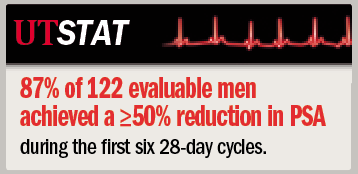Article
Abiraterone/low-dose prednisone show efficacy in PCa
Phase II study results show that daily treatment with abiraterone acetate (ZYTIGA), 1,000 mg, plus prednisone, 5 mg was very effective in lowering PSA levels in men with non-metastatic castrate-resistant prostate cancer (CRPC) at high risk for metastasis. Learn more

Charles J. Ryan, MDSan Francisco-Phase II study results show that daily treatment with abiraterone acetate (ZYTIGA), 1,000 mg, plus prednisone, 5 mg was very effective in lowering PSA levels in men with non-metastatic castrate-resistant prostate cancer (CRPC) at high risk for metastasis.
Read: Prostate cancer test could reduce overtreatment
Furthermore, the safety profile of the combination regimen was similar to that reported previously using abiraterone acetate with prednisone, 10 mg daily, reported Charles J. Ryan, MD. Dr. Ryan presented results from the phase II Impact of Abiraterone Acetate in Prostate-Specific Antigen (IMAAGEN) study at the AUA annual meeting in New Orleans.
Results from the primary outcome measure showed 87% of 122 evaluable men achieved a ≥50% reduction in PSA during the first six 28-day cycles. In analyses of other cutpoints for PSA lowering, 91% of men achieved a PSA reduction of at least 30% and 60% achieved a PSA reduction of at least 90%.
“The very high rate of PSA response in this patient population is encouraging and not unexpected considering the established efficacy of abiraterone acetate for treating metastatic CRPC. In addition, it appears that abiraterone is well tolerated for a relatively long period of time when administered with a lower dose of prednisone,” said Dr. Ryan, professor of clinical medicine and urology, University of California, San Francisco.
Read: Long-term PCa surveillance data point to favorable outcomes
“There does not appear to be any significant increase in grade 3/4 toxicities comparing the safety results to historical data from previous phase III studies where men received 10 mg of prednisone daily. At the time of the analysis, no patient in the study required an increase in prednisone dose to manage symptoms of mineralocorticoid excess, and there are many patients in the IMAAGEN study who have been treated with prednisone, 5 mg daily for longer than 2 years.”
Next: Phase II open-label trial
The phase II open-label trial enrolled 131 men at 38 sites between May 2011 and July 2013. Eligible patients had castrate serum testosterone levels (≤50 ng/mL) and a rising PSA (≥10.0 ng/mL or PSA doubling time of <10 months), as well as an Eastern Cooperative Oncology Group performance status <2.
READ: Prostate Ca radiation therapy cost drivers analyzed
Of the 131 men enrolled, 111 completed six cycles of treatment and entered follow-up. At the time of the data cutoff, median exposure time was 12 months, and 81 men remained on treatment. Disease progression was the reason for study discontinuation among 14 men, and it occurred in only two men prior to 6 months.

At baseline, the patients had a median PSA of 11.9 ng/mL and median PSA doubling time of 3.4 months.
“Clearly, this was a group at high risk for developing metastatic disease,” Dr. Ryan said.
Serum testosterone level decreased by approximately 96% after three and six treatment cycles; PSA was <0.20 ng/mL in 22% of men and <0.02 ng/mL in almost 6%.
Only 17.6% experienced PSA progression
Time to radiographic and PSA progression are being analyzed as secondary outcome measures. Median time to PSA progression-free survival and median time to radiographic progression-free survival were not yet achieved, and only 23 men (17.6%) had experienced PSA progression at the data cutoff. Kaplan Meier analysis estimates of PSA progression-free rates were 82% at 12 months, 73.5% at 18 months, and 63% at 24 months. Radiographic progression-free survival rates were estimated as 89% at 12 months and 87% at 18 and 24 months.
READ: Focal, whole-gland cryo yield similar cancer control
Almost half of the men had a grade 3 or higher adverse event, 29% had a serious adverse event, 27.5% had a serious adverse event of grade 3 or higher, and 11% withdrew from the study because of an adverse event. Four men had adverse events leading to death.
Grade 3 or higher hypertension occurred at a rate of 17% and grade 3 or higher hypokalemia occurred at a rate of 4.6%.
When asked about treating men with abiraterone using the lower dose of prednisone, Dr. Ryan stated that the data from the IMAAGEN study seem to support that approach, and he noted there is also substantial clinical experience with it. He said that he typically starts prednisone with 10 mg daily and reduces the dose if he thinks it is necessary. Dr. Ryan opined, however, that the current labeling recommending prednisone, 10 mg daily is not likely to change in the near future.
Dr. Ryan has received honoraria from Janssen Pharmaceuticals and Astellas and is an investigator and meeting participant/lecturer for Janssen. Several of his co-authors are consultants/advisers or investigators for, or employees of, Janssen.
















